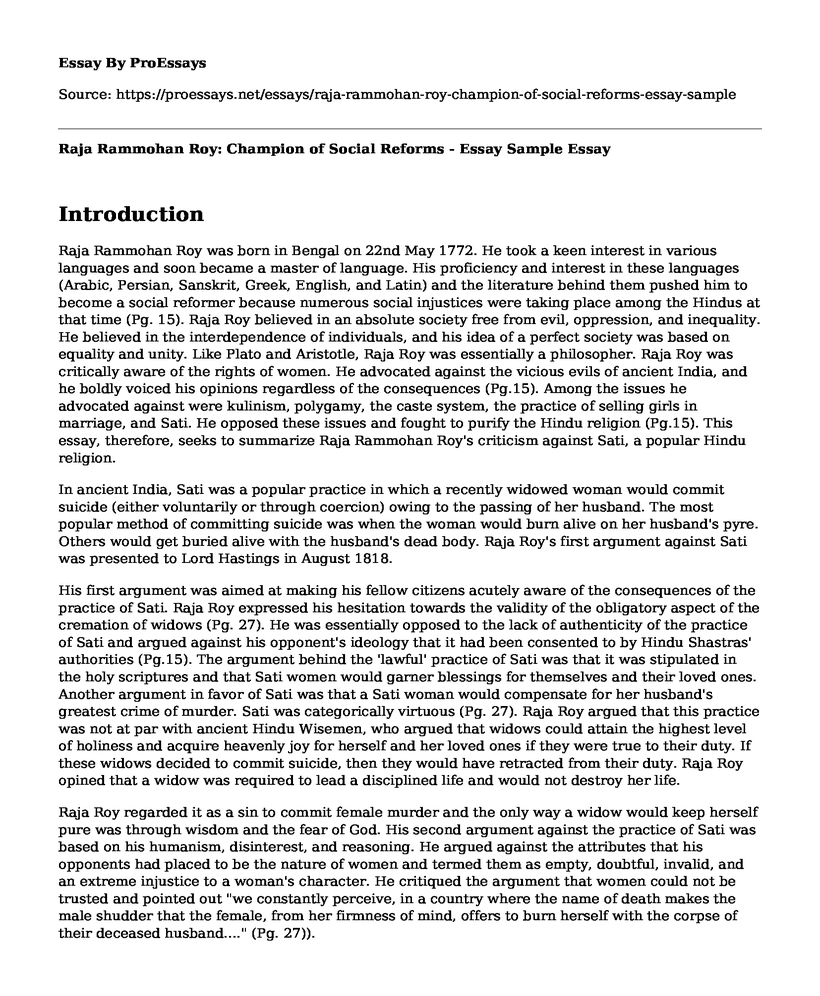Introduction
Raja Rammohan Roy was born in Bengal on 22nd May 1772. He took a keen interest in various languages and soon became a master of language. His proficiency and interest in these languages (Arabic, Persian, Sanskrit, Greek, English, and Latin) and the literature behind them pushed him to become a social reformer because numerous social injustices were taking place among the Hindus at that time (Pg. 15). Raja Roy believed in an absolute society free from evil, oppression, and inequality. He believed in the interdependence of individuals, and his idea of a perfect society was based on equality and unity. Like Plato and Aristotle, Raja Roy was essentially a philosopher. Raja Roy was critically aware of the rights of women. He advocated against the vicious evils of ancient India, and he boldly voiced his opinions regardless of the consequences (Pg.15). Among the issues he advocated against were kulinism, polygamy, the caste system, the practice of selling girls in marriage, and Sati. He opposed these issues and fought to purify the Hindu religion (Pg.15). This essay, therefore, seeks to summarize Raja Rammohan Roy's criticism against Sati, a popular Hindu religion.
In ancient India, Sati was a popular practice in which a recently widowed woman would commit suicide (either voluntarily or through coercion) owing to the passing of her husband. The most popular method of committing suicide was when the woman would burn alive on her husband's pyre. Others would get buried alive with the husband's dead body. Raja Roy's first argument against Sati was presented to Lord Hastings in August 1818.
His first argument was aimed at making his fellow citizens acutely aware of the consequences of the practice of Sati. Raja Roy expressed his hesitation towards the validity of the obligatory aspect of the cremation of widows (Pg. 27). He was essentially opposed to the lack of authenticity of the practice of Sati and argued against his opponent's ideology that it had been consented to by Hindu Shastras' authorities (Pg.15). The argument behind the 'lawful' practice of Sati was that it was stipulated in the holy scriptures and that Sati women would garner blessings for themselves and their loved ones. Another argument in favor of Sati was that a Sati woman would compensate for her husband's greatest crime of murder. Sati was categorically virtuous (Pg. 27). Raja Roy argued that this practice was not at par with ancient Hindu Wisemen, who argued that widows could attain the highest level of holiness and acquire heavenly joy for herself and her loved ones if they were true to their duty. If these widows decided to commit suicide, then they would have retracted from their duty. Raja Roy opined that a widow was required to lead a disciplined life and would not destroy her life.
Raja Roy regarded it as a sin to commit female murder and the only way a widow would keep herself pure was through wisdom and the fear of God. His second argument against the practice of Sati was based on his humanism, disinterest, and reasoning. He argued against the attributes that his opponents had placed to be the nature of women and termed them as empty, doubtful, invalid, and an extreme injustice to a woman's character. He critiqued the argument that women could not be trusted and pointed out "we constantly perceive, in a country where the name of death makes the male shudder that the female, from her firmness of mind, offers to burn herself with the corpse of their deceased husband...." (Pg. 27)).
He continued his criticism and argued that "With regard to their trustworthiness......If we enumerate such women in each village or town as having been deceived by men, and such men as having been betrayed by women, I presume that the number of deceased women would be found ten times greater than that of the betrayed men." (Pg. 27))
In all his arguments, Raji Roy demanded consciousness of the elites for women, particularly widows. He argued that women should be given equal opportunity to be true to themselves and freely express themselves. He made to abolish the practice of Sati in India.
References
Hay, S. N., & De Bary, W. T. (1988). Sources of Indian tradition. Motilal Banarsidass Publishers. Retrieved from https://www.worldcat.org/title/sources-of-indian-tradition/oclc/16093091
Cite this page
Raja Rammohan Roy: Champion of Social Reforms - Essay Sample. (2023, Feb 27). Retrieved from https://proessays.net/essays/raja-rammohan-roy-champion-of-social-reforms-essay-sample
If you are the original author of this essay and no longer wish to have it published on the ProEssays website, please click below to request its removal:
- Relevance for Semiotics for Contemporary Design Essay
- Graduation Essay From Middle School
- Essay Sample on Developmentally Appropriate Practice
- Writing and Evaluating Test Items Paper Example
- Paper Example on Phone Interview at Walden University: Data Collection & Instrumentation
- Sharpening Writing Skills: A Course for Success - Essay Sample
- Comparative Analysis: Hygiene Knowledge Among U.S. and Saudi Arabian Students







